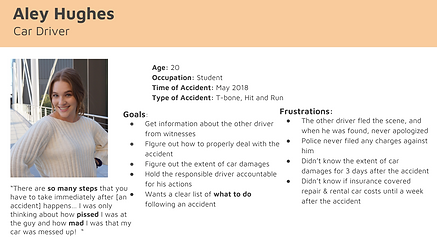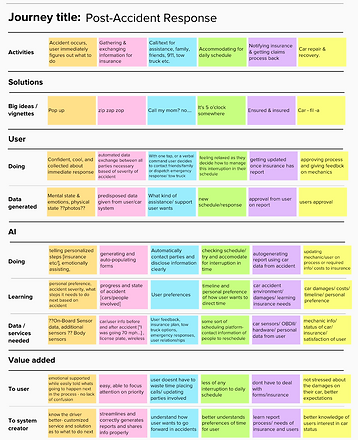
MAIA
Car Accident AI Assistant
Timeline
Sep. 2018 - Dec. 2018
Team
Meng Zhou
Lauren Kelliher
Mitchel Walker
Mustafa Abban
My Role
Video Design
UX Research
Interaction Design
Visual Design
Tools
Sketch
Adobe AE
OPPORTUNITY



70% crashes are property damage only -PDO crashes. The PDO crash process can be more simple and clear.
Confusion and lack of clarity on what to do in case of a car accident.
People feel shocked and alone when they are involved in a car accident.
DESIGN CHALLENGE
How Might We Make Post Car Accident Experience Better?
PRODUCT CONCEPT
Elevator Pitch
WHAT
WHO
Michael, a driver involved in a car accident, stays unflustered and informed about his car, environment, and necessary actions through an AI assistant which gathers and exchanges critical information in real-time with necessary parties.
HOW
KEY FEATURES
-
Neural Network - Interpret accident, determine damage
Currently, we use around 2500 videos (250,000 individual frames) to build a hierarchical recurrent neural net. Our ultimate goal is to train a model to make predictions for a wide variety of accident situations. The video could display on car screen or mobile device, which allows users to know the accident liability and determine car damage.




Listen MAIA
1. Immediate Damage & Cost Estimates
-
Automated diagnostics
-
Notify on degree of damage and cost
-
Auto-population of reports and forms
2. You'll feel GUIDED
-
Through personalized steps with what to do next
-
Having an updated personal schedule
3. NOTIFY necessary parties, fast & clearly
-
Automatic updates to those that are close to you
-
Easy, hands-free access to Emergency Respondents
4. Easily EXCHANGE and ACCESS information
-
“Go-to” guy, provide and get back all info: insurance company, other driver’s insurance type, repair store, insurance claiming, repair process, check in both progress.


-
Mobile Intelligent Voice Assistant - Guide users what to do in an accident
-
Car Sensor, OBD-II Port- - Detect and diagnose Car Damage
Through discussion with a teammate majoring in Mechanical Engineering, we decided to make use of most crucial engine sensors and diagnostic trouble code(DTC) to detect and diagnose car damage. See detailed research.

*Car Sensors

*OBD-II Port
User Research
"If you design for everybody, then you design for nobody"
Dale Fahnstrom
Secondary Research
Research Fields:
-
Post-car accident experience
-
Information flow throughout the process
-
Technology (could be) applied
-
Car accident fact/statistics
-
AI applied in (auto) insurance
Understand and articulate the problem
Activities
Potential Users
User Frame
Identifies:
-
A well defined group of users to study
-
A set of user activities to focus our research

Where the greatest overlaps exist
Who will use the work?
What do we intent to design?
Business Frame
Identifies:
-
A clearly defined and appropriate scope
-
Who is responsible for implementation

Problem
-
Car damage estimate process is inefficient, ambiguous, and stressful
-
Estimate accident cause/ liability is time-consuming and complicated
-
Communication with all persons involved is time-consuming and stressful
Objectives
-
Guide driver post car accident procedures
-
Estimate car damages quickly and effortlessly
-
Estimate accident cause/ liability quickly and effortlessly
-
Communicate with all persons involved quickly and effortlessly
Primary Research
-
Interview









10 Drivers




2 Insurers, 2 Mechanics
-
Persona




Four Insights Generated From Study


-
Immediate Communication
Characterized by collecting driver license and insurance information, and police collecting witness statements and on-site evidence. There is difficulty in collecting this information based on the context of the accident.
-
Confusion and lack of clarity on what to do
-
Initial shock
-
Priorities and personal schedules are really influential in this communication process
-
Language barriers add more difficulties
-
Basic information is repeated often between different parties
-
Devastation
-
Long Term Communication
Characterized by finding maintenance shops, calling insurance, contacting other drivers, managing costs. Lots of room for miscommunication or lack of communication.
-
A “go-to” guy is extremely helpful and valued, because it’s a personalized hub of good communication between all the involved parties.
-
The more personalized and transparent this communication can be the easier the accident may be resolved
-
Aggravation of dealing with the process and a damaged car
-
Costs & Damage
Characterized by several factors, such as insurance policy, what kind of car accident, etc., and varies from situation to situation.
-
A “go-to” guy is extremely helpful and valued, because it’s a personalized hub of good communication between all the involved parties.
-
The more personalized and transparent this communication can be the easier the accident may be resolved
-
Aggravation of dealing with the process and a damaged car
-
Time Consumption
-
Accidents typically take place during time-sensitive moments, people rarely make the time to get into an accident
-
Repair process is highly variable on how long it can take
-
Insurance companies are overloaded with how many claims they file each day, especially because they don’t have technology to help them, their work flow is inefficient. It takes a lot of communication between many parties.
Cognitive Journey Map

Experience Principle
Make communication clear and fast
No one has time for an accident, but rushing communication can cause worse consequences.
-
Many parties are communicating leading to potential miscommunication
-
Miscommunication is very expensive
Make important decisions simple and fast
Especially when not knowing all the information, making a wrong decision can be very costly.
-
People generally don’t understand repair processes
-
Minimizing cost is most important
-
Liability can be unclear because people are biased
Design Thinking Board
We used the design thinking board to think through, design, and plan for the aspects of cognition and machine learning that AI services offer for amplifying user experiences and back end capabilities.
1. Jobs to be done
(Look at each little activity for AI opportunities)
2. AI value map
(Understand which AI opportunities will add the most value to the user and the creator)

3. To-Be Journey with AI
(Use everything we’ve considered so far to create a
new vision for our journey)


4. Idea Prioritization
(Decide on which ideas to pursue by weighing their value over their feasibility.)

Design
-
Group Brainstorming, whiteboard sketch



-
AI Mobile Assistant Concept Workflow


-
AI Model Workflow for Insurance Claim

The Future of MAIA

Cars built with increasing technology
- Wireless connections
- Built-in cameras & proximity sensors
- Interactive displays
Rise of car-sharing
- Streamline maintenance process
- Quick change of vehicles
- Built-in cameras & proximity sensors
- Interactive displays
Self-Driving Cars
- Liability on tech owner
Future Considerations
-
Injuries or fatalities
-
Data Security & Privacy
-
Two-factor authentication with driver phone
-
User confirmation required before other parties are communicated
-
-
Accessibility
-
Software runs automatically
-
Prompts user at the detection of an accident
-
-
Liability Disputes
-
Identifying other drivers (license plates, facial recognition)
-
Reckless driving penalties
MAIA Final Presentation!
